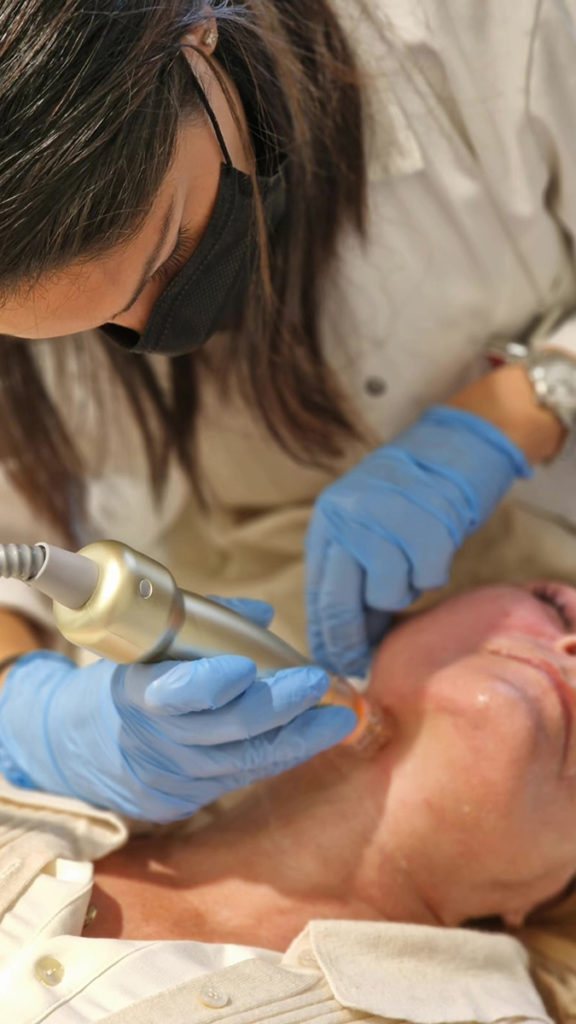As the frosty winds start to nip at the picturesque streets of Stockholm, one thing becomes abundantly clear – winter is on the horizon!❄️ But what does this season mean for your skin? In our quest to unravel the secrets of maintaining a healthy, glowing complexion in the midst of the Swedish winter wonderland, we turn to the expertise of none other than Dr. Ros-Ninva Poli, a distinguished medical doctor based at Timra Medical in Vasastan. Join us as we delve into her insights, practical tips, and skincare wisdom to help you navigate the winter season with confidence and radiance.
What are the most common mistakes people make when caring for their skin in winter, and how can they avoid them?
Dr. Ros-Nivna Poli: One common mistake is skipping SPF during winter. Just because it’s cold doesn’t mean the sun can’t cause photo damage to your skin, especially in regions where the sun is low, like in the northern parts of Sweden. I personally use SPF 50 year-round, especially during winter, such as when skiing. Exposure to UV radiation is high if there is snow on the ground because it reflects the sun’s harmful rays, and there is a high risk of burning your face. Also, while most people in Sweden know the importance of moisturizing their skin more often in winter, especially in exposed areas like hands and face, not everyone is aware that this should not be done right before going outdoors, particularly if it’s below zero degrees. When you apply moisturizer to skin that’s in a wrinkle or fold and it’s exposed to cold, it can expand and cause microdamage in the skin, making it more sensitive. It’s advisable to apply moisturizer 1-2 hours before heading out in winter.
So, what kind of sun protection would you recommend?
It’s preferable to use a non-comedogenic SPF that won’t clog pores. During winter, it’s not as critical to choose a waterproof SPF.
What are some of the key challenges our skin faces during the winter season in this region, and how can people effectively tackle them?
The primary challenge is dryness. Many people in Sweden have an atopic tendency that can worsen when it is cold outside, resulting in issues ranging from dry skin to eczema. That is why frequent moisturizing is crucial, along with moisturizing after contact with water. The choice of moisturizer should be adjusted based on the area of application, using a heavier one for the hands, for example, compared to the face. If these measures aren’t sufficient and skin problems develop, I would advise seeking consultation with a family doctor.
How can one adjust the skincare compared to other seasons? Are there any specific day and night routines you suggest?
The minimum day routine should include a cleanser, vitamin C, moisturizer, and SPF. The minimum night routine should involve a cleanser, vitamin C, and a more potent cream with regenerative, antioxidant, or rejuvenating properties, which is particularly beneficial for more mature and demanding complexions. Products containing Vitamin C are particularly important as they can help brighten and even out the skin tone, reduce the appearance of fine lines, and provide antioxidant protection. They are beneficial for a wide range of skin types, including those with concerns about hyperpigmentation, dullness, or premature aging. I would also recommend using retinol at least once a week.
What is so special about retinol?
Retinol has an ability to enhance skin cell turnover, promote collagen production, and address common skin concerns such as fine lines and uneven texture, helping you maintain a healthier and more radiant complexion in the harsher winter months. Note though that retinol is not advised during pregnancy and breastfeeding. Products containing retinol are essential year-round, but they may occasionally lead to flaking. If your skin tends to be dry, especially during the winter, this effect can be more pronounced.
What’s the role of exfoliation in a winter skincare routine, and how frequently should it be done?
Exfoliation serves to remove dead skin cells and built-up dirt from the skin’s surface, providing a deeper cleanse. The frequency of exfoliation should be determined on an individual basis, and it’s advisable to consult with a skin therapist or aesthetic doctor for a personalized evaluation of your skin, which may evolve with age. Proper exfoliation can help maintain skin health and a youthful appearance. The frequency of using a scrub or exfoliating product should be based on your skin type. For those with normal to oily skin, using a scrub 2-3 times a week is usually suitable. If you have combination skin, exfoliating 1-2 times a week is generally enough. However, if you have dry or sensitive skin, it’s best to exfoliate less frequently, typically once a week or even every other week, to prevent skin irritation. Remember that over-exfoliation can lead to skin irritation and sensitivity. It’s essential to listen to your skin and adjust the frequency based on how your skin responds.
Are there any specific foods or supplements that can support skin health during winter?
Absolutely! Think of it as your skin’s winter survival kit. You’ll want to load up on Vitamin A, various B vitamins (like B2, B3, and B7), Vitamin C, and Vitamin E. These goodies are your skin’s best friends, helping it stay healthy and tackle the challenges that the cold season throws at it. And don’t forget about zinc and selenium – they’re like the bodyguards for your skin cells, shielding them from the stress that winter can bring. Now, about collagen supplements, they’re quite popular, but here’s the thing: there’s a chance they might not work as expected because they could break down or go inactive in your gut.
Are there any lifestyle habits or practices that you suggest to complement a winter skincare routine?
You got it! it’s not just about products! Staying hydrated is crucial, and having a humidifier at home can be a real skin-saver during the dry winter season. When it comes to makeup, consider using hydrating products to keep your skin looking fresh. And don’t forget about fitness – hitting the gym or engaging in regular physical activity can also boost your skin’s health. Exercise gets that blood flowing and can contribute to a healthy, glowing complexion, even in the harshest winter weather.
So, what about those fancy in-salon treatments or facials for the winter season?
Oh, definitely! There are a couple of game-changers. First up, we’ve got the skin boosters – they’re like a mega-dose of hydration without messing with your facial features. And then, there’s the SylfirmX treatment, which is a combo of Dermapen and Radiofrequency. This one’s all about giving you that radiant skin. It works on tone, texture, and pumps up the rejuvenation by kicking your collagen production into high gear. Winter won’t know what hit it!

Thank you very much for your time and the useful tips!
You can find more information and contact details on Instagram: @timramedical













1 Comment